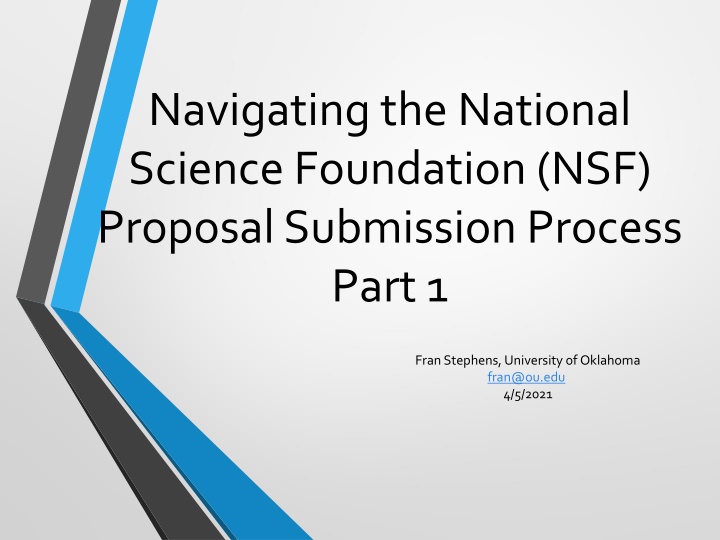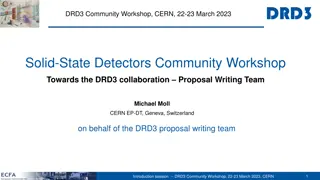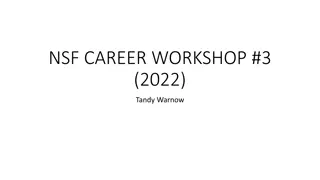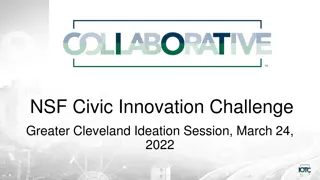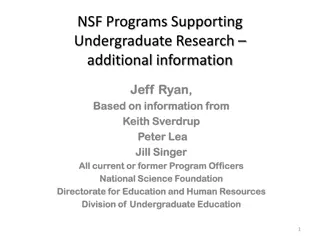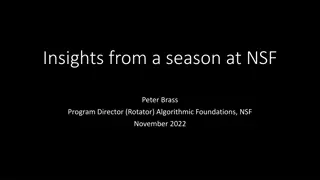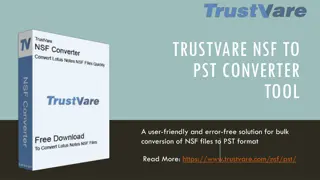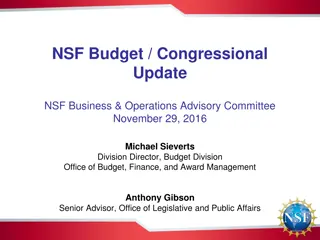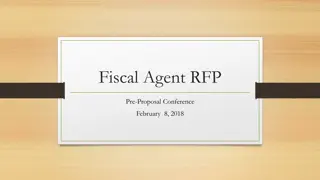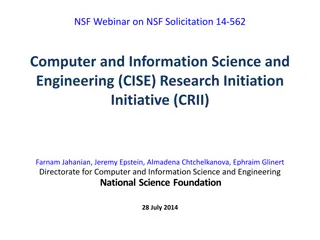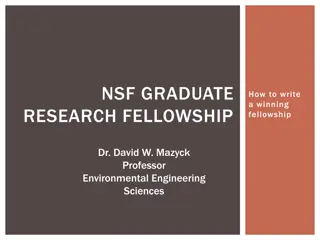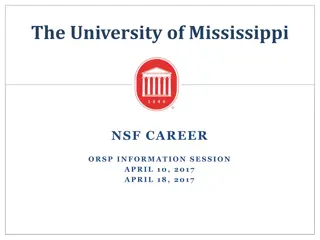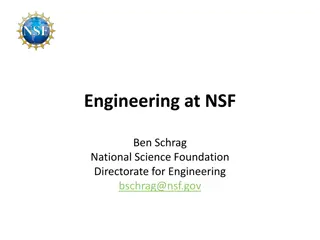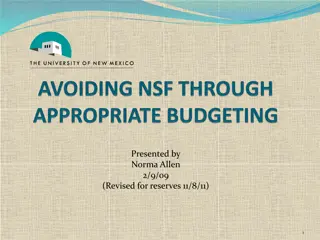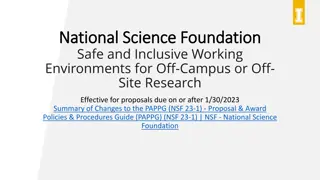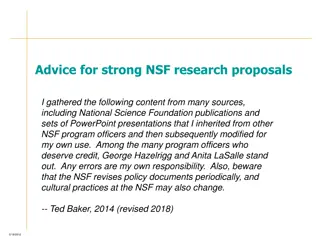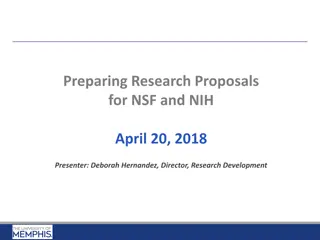Navigating NSF Proposal Submission Process
This guide provides an overview of the National Science Foundation (NSF) Proposal Submission Process, including background information, proposal contents format guidance, common requirements, post-submission actions, and more. Learn about NSF's mission, goals, leadership structure, directorates, support for science and engineering education, and the importance of basic research in advancing science and knowledge.
Download Presentation

Please find below an Image/Link to download the presentation.
The content on the website is provided AS IS for your information and personal use only. It may not be sold, licensed, or shared on other websites without obtaining consent from the author.If you encounter any issues during the download, it is possible that the publisher has removed the file from their server.
You are allowed to download the files provided on this website for personal or commercial use, subject to the condition that they are used lawfully. All files are the property of their respective owners.
The content on the website is provided AS IS for your information and personal use only. It may not be sold, licensed, or shared on other websites without obtaining consent from the author.
E N D
Presentation Transcript
Navigating the National Science Foundation (NSF) Proposal Submission Process Part 1 Fran Stephens, University of Oklahoma fran@ou.edu 4/5/2021
NSF Proposal Submission. Part 1: Background Information NSF Website who we are, what we do, how we work General information Submission Portals Take-a-Way Part 2: Proposal Contents Format Guidance Common Proposal Requirements and Issues-Tab by Tab Take-a-Way Part 3: After Submission Other Actions Review Special Notes and Take-a-Way
NSF Proposal Submission. Part 1: Background Information NSF Website who we are, what we do, how we work General information Submission Portals Take-a-Way
NSF Proposal Submission. At a Glance | NSF - National Science Foundation Independent Federal Agency created by Congress to promote the progress of science; to advance the national health, prosperity, and welfare; to secure the national defense. Average proposal is 3 years NSF's goals -- discovery, learning, research infrastructure and stewardship Another essential element in NSF's mission is support for science and engineering education, from pre-K through graduate school and beyond. The research we fund is thoroughly integrated with education to help ensure that there will always be plenty of skilled people available to work in new and emerging scientific, engineering and technological fields, and plenty of capable teachers to educate the next generation
NSF Proposal Submission. Who we are Leadership is a Director and a 24-member National Science Board (6-year terms) NSF is divided into the following seven directorates that support science and engineering research and education: Biological Sciences, Computer and Information Science and Engineering, Engineering, Geosciences, Mathematical and Physical Sciences, Social, Behavioral and Economic Sciences, and Education and Human Resources. Each directorate is headed by an assistant director and each is further subdivided into divisions like materials research, ocean sciences and behavioral and cognitive sciences. Each division has program officers, most who serve on a rotating schedule of 2-3 years.
NSF Proposal Submission. What we do Supports basic research and people to create knowledge to transform the future to promote the progress of science; to advance the national health, prosperity, and welfare; to secure the national defense...
NSF Proposal Submission. How we do it Proposals may be submitted to solicitations or as unsolicited proposals Funding opportunities fall into three categories Program descriptions Program announcements Program solicitations
NSF Proposal Submission. NSF Submission Process -General Comments Most recent update to NSF guidance is NSF 20-1 effective 6/1/2020 In 2017 NSF replaced the Grant Proposal Guide (GPG) and Award Administration Guide (AAG) with a combined document called the NSF Proposal & Award Policies & Procedures Guide (PAPPG) Must follow PAPPG unless specific solicitation deviates or written approval from NSF assistant directors/Office head or designee Be aware when writing your proposal that you will need to use the specific solicitation and general guidance; make sure most current versions used. Unsolicited proposals fall under PAPPG Who may submit Organization is normally considered the submitter except on a few proposals that are paid to individuals like some fellowships Organization must have DUNS/UIN and SAM registration OU has all of these.
NSF Proposal Submissions. NSF Submission Process - Types of Proposals Letters of Intent (mainly COI/gauge interest at NSF) Usually, can be submitted by PI but some require SRO/AOR submission Some are required and some are requested Some have hard deadlines Preliminary/Pre-proposal (COI use and go/no go indication) Usually require less proposal documents to be uploaded than a regular proposal (but there are some very complicated ones too) May have a wide variety of special instructions Often have a zero or $2 budget entry Require submission by SRO/AOR Usually have hard deadline Increasing trend Some are very complicated and may have detailed budgets Pay close attention to solicitation! If required you must do!
NSF Proposal Submissions. NSF Submission Process - Types of Proposals Both an LOI and a Preliminary proposal may be required or requested/recommended May be invite or not invite (decision final) May be encouraged or discouraged (decision advisory) Collaborative submission by multiple organizations usually only do one LOI or Preliminary for the whole proposal Full Proposal (shows objectives and significance of research, qualifications of PI/team/organization, amount of funding, etc. Some require LOI or Preliminary to submit Most are in done by PI in response to call for proposals from NSF Standard proposal tabs for full proposal will be covered later in presentation
NSF Proposal Submissions. Overview of NSF Submission Process - Types of Proposals Special proposals Usually deviate from normal full proposal instructions May be a stand-alone submission or some may be done as part of a regular full proposal submission or may be tied to a prior submission Some have specific budget and time limits Examples: Rapid Response Research Proposal (RAPID); Early-concept Grants for Exploratory Research (EAGER); Research Advanced by Interdisciplinary Science and Engineering (RAISE); Grant Opportunities for Academic Liaison with Industry (GOALI); Ideas Lab; Facilitation Awards for Scientists and Engineers with Disabilities (FASED); Supplemental Funding; Conference Proposals; Equipment Proposals; Travel Proposals (recent change now allowed for domestic travel); Center Proposals; Research Infrastructure Proposal Dear Colleague Letters (DCL) not considered a proposal and usually for information only but can contain proposal submission instructions
NSF Proposal Submissions. Overview of NSF Submission Process Deadlines Deadline if date given is 5 pm local Deadline no acceptance after the deadline date; no exceptions except unusual circumstances (NSF closed, natural/anthropogenic disaster, organization unable to submit) If a deadline falls on a weekend or holiday it is extended to following business day Submission window end date is the same as a deadline date Target proposal is accepted after deadline, but it may miss a review panel or meeting (consequential funding impact) (recommend consider target same as Deadline) Collaborative submission by multiple organizations must be submitted by all organizations before deadline by each locality or entire proposal is rejected. Some Divisions in NSF are going to no-deadline submissions (open window/rolling deadline) which means you can submit throughout the year requires close communication with the program officer or you may miss a review panel.
NSF Proposal Submissions. NSF Proposal Submission Portals Grants.gov (rarely used) Fastlane (primary focus) Research.gov (replacing Fastlane)
NSF Proposal Submissions. Grants.gov submissions for NSF Not all NSF proposals can be submitted via grants.gov but most can (Collaborative, updates, and revisions must be done through Fastlane). OU has a grants.gov log in; PI still needs Fastlane account set up. Budget and subcontract budget is much harder to load. Checklist form must be completed. Be very careful with compatible adobe versions, file names and name length, and file extensions. Types of files needed are same as Fastlane (Summary, description, etc.). Access to submitted proposal cannot be done through grants.gov; submission will actually post into Fastlane. At OU we consider all NSF submissions as going in via Fastlane or Research.gov unless the PI tells us otherwise well in advance.
NSF Proposal Submissions. PI Starts Proposal in Fastlane or Research.gov PI needs NSF ID number, password, affiliation with organization (only one id) Organizations usually have a point of contact for limited Fastlane assistance such as affiliation and account set up (OU has link on the Grants section of VPRP website) All other Co-PIs will also need an NSF ID and password the PI will use that ID (or their email) to add the Co-PIs to the Cover Sheet (they must set their id up and affiliate with their organization not using OUs links) In Fastlane go under Proposal Functions, create your proposal In Rgov Prepare New Proposal will step you through all the entries until you get to the page with all the tabs to load files.
NSF Proposal Submissions. SRO Access/PINs PI allows SRO Access (this means ORS can see it) Options are Read, Edit, and Submit Read and Edit are minimum if ORS is to help you Different SRO offices will do different levels of assistance and the level of assistance possible may vary depending on deadlines and timing Recommend do all three at one time but it is the PI s option PI will receive warnings and errors if items need to be loaded when you give access just hit proceed PI will still have access with SRO Assignment of Pin (if needed) PI needs to assign pin Pin needed for collaborative proposal from multiple organization Useful if you want Senior Personnel or other people to review items loaded (with the proposal number and pin anyone in the world with Fastlane account can log in to see what you have loaded).
NSF Proposal Submissions. Research.gov is replacing Fastlane Essentially it is Fastlane part 2 many of the features are the same or similar but there is improved file handling and error checking Reporting has been done in Research.gov for a couple of years now. Most submissions can now be done in either Fastlane or Research.gov; some must be done in Rgov. In the past we recommended using Fastlane as much as possible while bugs were being worked out of the Research.gov website. If you have a simple proposal (especially without subcontracts) you might consider giving Research.gov a try. Indications we are hearing is that Fastlane will start phasing out in FY 22/23.
NSF Proposal Submissions. Organizational/Internal Considerations At OU completion of the routing is what gives the PI and ORS the permission to submit any proposal Be cognizant of submitting accurate subcontract and consultant information is what you are submitting officially approved? Who has what level of access/authority in Fastlane/Rgov for submission, reports, agreements, etc. (at OU submission and agreements are done by ORS, most technical reports are done by the PI but some may be submitted by ORS, most financial reports are done by ReFS) Who is responsible for loading what parts of a Fastlane/Rgov submission? (At OU the PI is responsible for loading all the parts except the Budget tab; however, the PDS may assist with loading other files developed by the PI as they are able [a lot depends on timing of request and workload])
NSF Proposal Submissions. Limited Competition (solicitation limits numbers of submissions) If an organizational limit is specified in the solicitation, it is normal for there to be some form of internal competition (and set deadlines for this competition) The solicitation may prescribe limits on how many proposals can be submitted by the organization (including subcontracts), by the PI, or by the PI as a CoPI. At OU, internal competitions are conducted by ORS. Participation in subcontracts may also impact the organizational limits so be aware. If an organization (or PI) submits more than the allowed amount of proposals it can cause ALL proposals to be rejected or they may accept the first one(s) received (it is usually the PO s choice).
NSF Proposal Submissions. Take-a-Way If you are a PI, decide your division(s) of interest When Director changes some programs will change Program Officer changes can also change focus of funding Communicate/Get to know your Program Officer your research If you aren t sure about submitting to a solicitation, send a 1-page paper on ORS can answer or submission system questions) Ask about budget or direction questions ( Don t ask them questions Consider Broader Impacts (and include funding in the budget) Consider Education if possible Check new PAPPG when it posts for comments (usually in the fall) Start learning Research.gov
